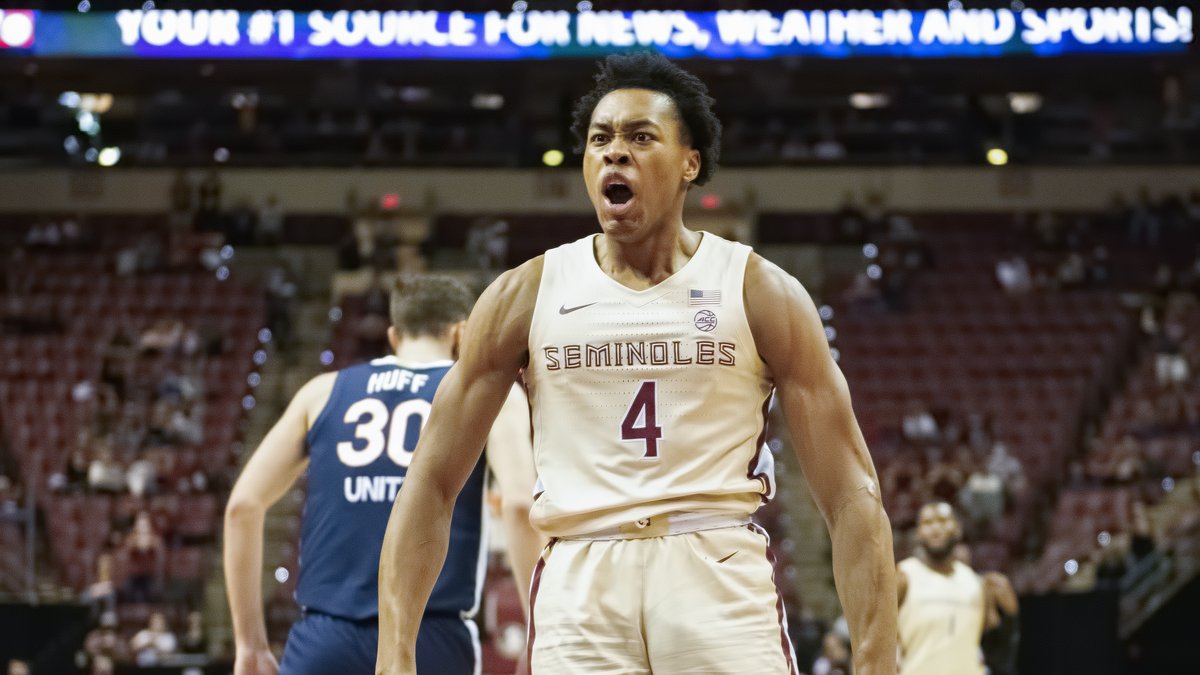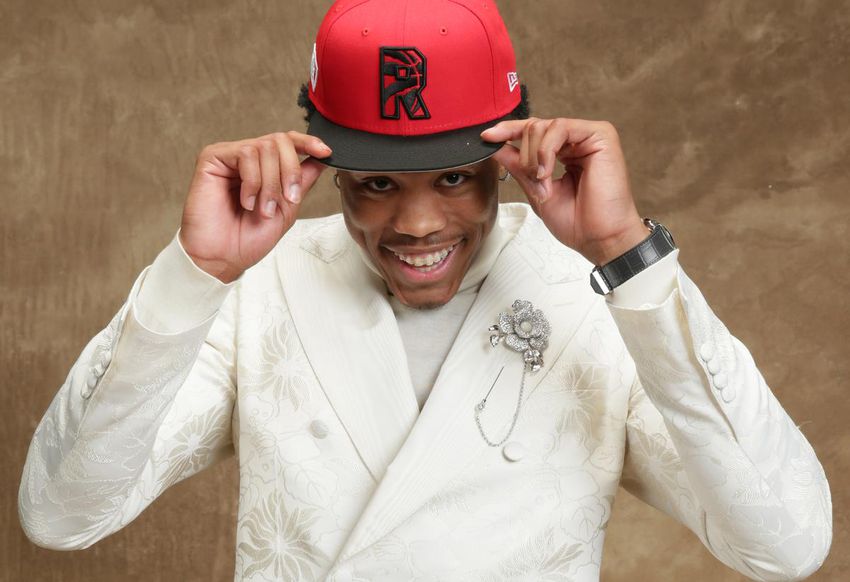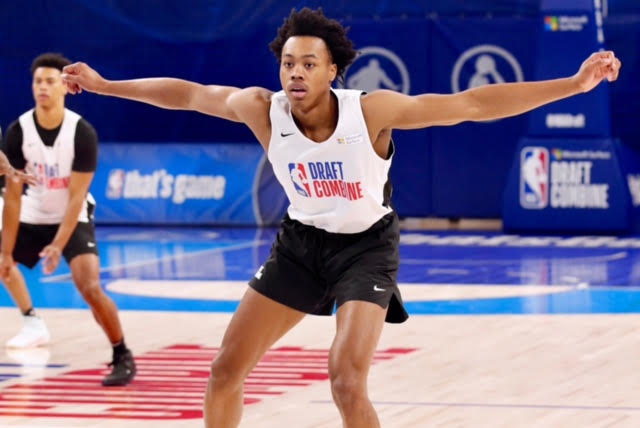With the 4th pick in the 2021 NBA Draft, the Toronto Raptors defied convention by selecting Scottie Barnes, a 19-year-old, 6-foot 9 wing out of Florida State University.
It was a surprising move considering the Raptors’ lack of a long-term answer at point guard and Jalen Suggs being on the board, a high-floor, high-ceiling player who represented one of the most safe picks in the draft and a much cleaner fit on the Raptors as currently constructed. Suggs was supposed to fit right into Kyle Lowry’s spot as the starting point guard next season (or run the bench), and the Raptors were supposed to run it back with a ready-made NBA player who just led the Gonzaga Bulldogs to one of the most dominant seasons in college basketball history.
Instead, the Raptors went off the board, reaching for a player who until recently was closer to 10 than he was to 4 on most mock drafts, who is much more raw on the offensive end than Suggs, and who projects to come off the bench next season and into the near future considering the Raptors’ already have OG Anunoby and Pascal Siakam at the wing spots.
So, why did the Raptors take Barnes at No. 4?
Well, Barnes was a late riser in the draft due in large part to his jaw-dropping workouts: he had a great day at the NBA combine, with a 36.00″ standing vertical leap and a 7-foot-3 wingspan, and their are rumours that he crushed the Raptors’ workout while Suggs did not (potentially tanking it on purpose, but who knows). As ESPN’s Mike Schmitz talked about on a recent episode of the Woj Pod, teams are putting a lot of emphasis into private workouts and the interview process these days — more so than they did in the past, especially with COVID — and with Barnes’ elite athleticism and infectious personality, it’s not hard to understand why he rose so much during that process.
You know the vibes
Open Gym: Moment presented by @Bell pic.twitter.com/SHyzemt81O
— Toronto Raptors (@Raptors) July 30, 2021
However, I would be at least a little concerned if the Raptors did, in fact, take him due to the workout process. After all, you can learn so much more about a basketball player from what they do in-game situations than you can from 1-on-0 workouts and the like, especially when it comes to their feel of the game and ability to create advantages within the context of 5-on-5 basketball. Maybe Suggs really didn’t want to come to Toronto, and if that’s the case, it would be difficult to justify drafting him that high. But there have been instances of that mindset hurting teams, such as when James Harden allegedly tanked his workout with the Memphis Grizzles, who opted to select the more athletic Hasheem Tabbeet over him.
Only time will tell how good Barnes can be and, just as important, how he will fit into the Raptors’ roster and into their system. Let’s start with where he is now, then analyze how he fits into the current roster, and finally end with his near-perfect fit into Nick Nurse’s system.
Barnes is a defensive-minded player who averaged 10.3 points on 50.3 percent shooting, 4.1 assists and 4.0 rebounds per game in his rookie season at Florida State. He was named the ACC Rookie of the Year, an All-ACC Third Team member and the ACC Sixth Man of the Year. He can legitimately guard one-through-five and was often tasked with picking up point guards full-court in college, which he did a surprisingly good job at. Someone as big and strong as Barnes simply shouldn’t move as fast as he does, and his greatest asset at this point in his career is his ability to defend and the versatility he provides within different defensive schemes.
The problems come on offense. As of right now — and remember, he is 19 years old and still very much developing every aspect of his game after only one college season — Barnes gets his offense in transition but is a liability in the half-court (or at least he will be in the NBA) due in part to his lack of a jump-shot. Barnes only attempted 1.7 threes per game and hit 27.5 percent of them. The Seminoles played him at point guard often last season and he is an incredibly gifted passer for his size, averaging 4.1 assists and 2.5 turnovers last season, but without a jump-shot, defenses can sag off of him into the paint, hurting the spacing for him and his teammates. Nick Nurse believes that his jump shot is not broken, it just needs some work, but many draft analysts are more sceptical that it can be fixed. If not, he’ll have to improve his finishing around the rim and in the mid-range and become more of a screen-and-roll guy off the ball and playmaker on it (like Giannis Antetokounmpo).
So, how does the player I just described fit into the Raptors roster? The real answer is that we don’t know because it is still unclear who will be back next season, but assuming the core of Fred VanVleet, Anunoby, and Siakam is back, it is hard to figure out where Barnes fits into that. He is likely not big enough to start at the center, and his ball-handling is probably not good enough to start at the point guard, which means he projects to come off the bench as a backup wing for now. That is totally fine for a rookie, but the path to the starting or finishing lineup is murky for Barnes as long as Anunoby and Siakam are still Raptors, so the Raptors must either be planning some more moves OR they believe that Barnes can develop into their future point guard or center.
It’s not as crazy as it sounds.
Firstly, the Raptors under Nick Nurse share playmaking duties anyway, so they are never going to ask Barnes to have the ball in his hands all game. They had one of the best game-managers in the NBA in Kyle Lowry and didn’t even ask him to do that. Barnes can share playmaking duties with VanVleet and Siakam, and that is likely enough playmaking to survive in the half-court.
The really interesting aspect to me of Barnes’ game is his potential fit as a pseudo-center. Think about it: you sub Norman Powell out of the small-ball lineup for Barnes, and that lineup just became a whole lot more switchable, athletic, long, and hard to contend with. Of course, the shooting is not ideal, but bring Lowry back and four of the five players are decent three-point shooters, so it could be a lineup that the Raptors close games with if Barnes’ development goes well.
People say to always draft for upside over fit, but fit still needs to be taken into account. Otherwise, players simply wouldn’t be able to play their natural position and be put in good positions to succeed. With Barnes, this is a pick that defies convention not just in a sense that the Raptors reached for him, but also in the way they project to use him.
Unlike most teams who are going all-in on offense right now in a league that has more spacing and skill than ever before, the Raptors are betting that defense (and transition offense) can still win championships. That’s simplifying it, for sure, but adding Barnes to already one of the most versatile defensive teams in the league is sure to make them extremely difficult to score on for many years to come. Think about it: in Anunoby and Barnes, the Raptors have two of the maybe five NBA players who can legitimately guard 1-through-five.
More than that, Barnes projects to fit into Nick Nurse’s defensive scheme perfectly, with his ability to guard multiple positions and cover lots of ground enabling the Raptors aggressively double-team ball-handlers and recover even better, the one aspect of the Raptors that makes them truly unique to watch. The half-court offense is going to be a big issue, with their lack of shot-creators being a real problem, but Barnes will immediately help on the defensive end and, by not demanding shots, will get his teammates involved by moving the ball offensively.
It’s not a perfect fit by any means, but the truth is that nobody knows how good any of these teenagers are going to be five years down the line. The Raptors believe in Barnes, and because of that, you should too.



